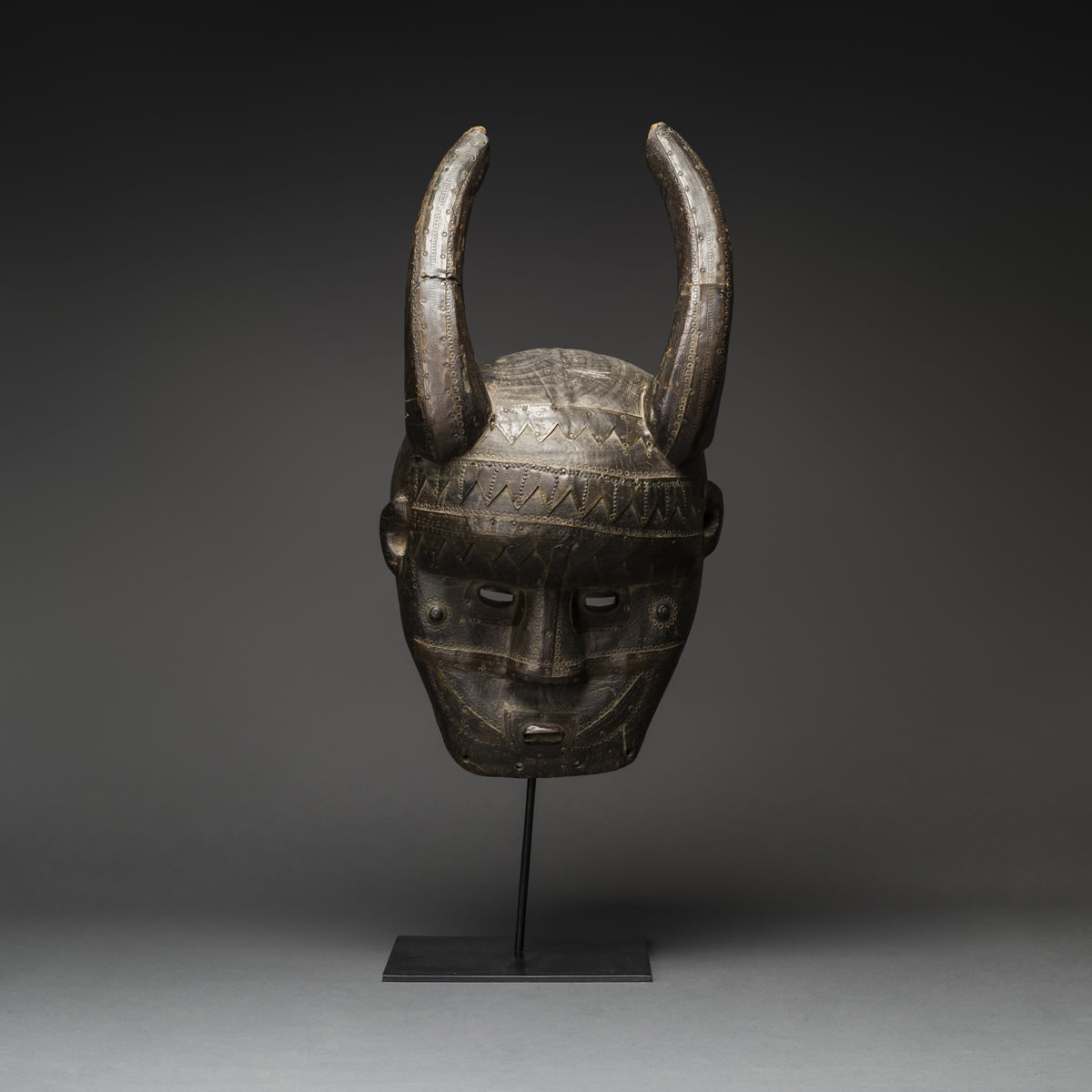Malinke Wooden Horned Mask, 20th Century CE
Wood and Brass
34.3 x 61 cm
13 1/2 x 24 in
13 1/2 x 24 in
PF.4010 (LSO)
This imposing semi-helmet mask was made by the Malinke (or Maninka) people of West Africa. It is an exceptionally dominant piece. It has a broad, flat face with a wide...
This imposing semi-helmet mask was made by the Malinke (or Maninka) people of West Africa. It is an exceptionally dominant piece. It has a broad, flat face with a wide nose, slit eyes and a bulging forehead, all covered (and defined, in the case of the eyes) with applied metal plates decorated with hammered, incised markings. The forehead is decorated with three saw-edges strips, while strips define the nose, cheeks and mouth. The wood is also decorated with punched awl marks. The face is dominated by a pair of tall horns that sweep upwards and backwards. The edges of the rear are well worn, and the perimeter is surrounded with a series of holes that imply the attachment of a costume. The surface is very dark, through a combination of stain and use-wear.
The Malinke are distributed as a minority in Guinea, Mali, the Ivory Coast, Senegal, Gambia, and smaller groups in Sierra Leone, B.Faso, Guinea-Bissau, Liberia and Ghana. They are part of the Mande group, and stem from an 8th century AD entity known as the Malinke Empire, which was a very powerful trading body. Modern Malinke are agriculturists, and live in male-dominated, hierarchical societies. Despite their population size and wide distribution, their contribution to Africa’s artistic heritage is minimal, as they are predominantly Muslim and believe that representative arts fly in the face of Islamic convention. This mask is therefore something of a rarity.
Its significance is uncertain. Before being colonised by Muslim groups, the populations in this area were polytheist and “idolatrous”, but their art has been destroyed and the traditions abandoned. This piece could be either an anecdotal object, or a memorial object from a lost cultural heritage. Its demonic appearance says something about what it was meant to represent – power, evil, males, or the strength of nature – although we are unsure about how it was used, beyond being a masquerade object. This is a rare and unusual piece of African art.
The Malinke are distributed as a minority in Guinea, Mali, the Ivory Coast, Senegal, Gambia, and smaller groups in Sierra Leone, B.Faso, Guinea-Bissau, Liberia and Ghana. They are part of the Mande group, and stem from an 8th century AD entity known as the Malinke Empire, which was a very powerful trading body. Modern Malinke are agriculturists, and live in male-dominated, hierarchical societies. Despite their population size and wide distribution, their contribution to Africa’s artistic heritage is minimal, as they are predominantly Muslim and believe that representative arts fly in the face of Islamic convention. This mask is therefore something of a rarity.
Its significance is uncertain. Before being colonised by Muslim groups, the populations in this area were polytheist and “idolatrous”, but their art has been destroyed and the traditions abandoned. This piece could be either an anecdotal object, or a memorial object from a lost cultural heritage. Its demonic appearance says something about what it was meant to represent – power, evil, males, or the strength of nature – although we are unsure about how it was used, beyond being a masquerade object. This is a rare and unusual piece of African art.
Literature
V22



